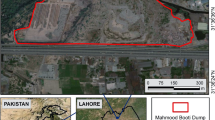Abstract
Urbanization and rapid population growth have led to significant waste generation, which is estimated to be around 3.4 billion tonnes globally in the upcoming 3 decades. In North America, landfilling is still the major waste treatment method; despite numerous stringent environmental regulations and public education programs on waste recycling. Unsustainable disposal practices and poorly managed landfills may have adverse effects on our environment, particularly from the fugitive emissions of landfill gases and toxic pollutants. As such, identification of problematic waste disposal sites and their fugitive emissions are of practical interest. The objective of the current study is to use land surface temperature as a proxy method to detect potential fugitive emission spots and their displacements at the City of Regina landfill using satellite imagery. Literature suggests higher land surface temperatures in disposal sites originate from the decomposition of organics, producing fugitive emissions of methane gas. Land surface temperature at the study area is computed using a set of empirical equations. Using a relative scale, hot spots at the Regina site are identified. Since applied remote sensing imagery is publicly available, it is believed that proposed method is equally applicable to other geo-spatial analysis of waste sites. Preliminary results for study area suggest that fugitive emissions occur near northern and southern central regions of the landfill. The southern region is larger compared to the northern one. This might be because of higher deposited waste with a higher proportion of organic material and maturity of waste, since methane gas release mostly comes from anaerobic process which occurs after aerobic decomposition.
Access this chapter
Tax calculation will be finalised at checkout
Purchases are for personal use only
Similar content being viewed by others
References
Butt TE, Lockley E, Oduyemi KO (2008) Risk assessment of landfill disposal sites–state of the art. Waste Manage 28:952–964
Cointreau S (2006) Occupational and environmental health issues of solid waste management: special emphasis on middle-and lower-income countries. Urban papers, 2 pages?
EPA (environmental protection agency) (2020) Basic information about landfill gas from https://www.epa.gov/lmop/basic-information-about-landfill-gas. Retrieved by 24 Feb 2020
Government of Saskatchewan (2017) Saskatchewan solid waste management strategy – discussion paper March 2017. Accessed on http://publications.gov.sk.ca/documents/66/97825-Solid%20Waste%20Management%20Strategy%20Discussion%20Paper.pdf by 25 Mar 2022
Iacoboaea C, Petrescu F (2013) Landfill monitoring using remote sensing: a case study of Glina, Romania. Waste Manage Res 31:1075–1080
Javadinejad S, Eslamian S, Ostad-Ali-Askari K (2019) Investigation of monthly and seasonal changes of methane gas with respect to climate change using satellite data. Appl Water Sci 9:180
Karimi N, Richter A, Ng KTW (2020) Siting and ranking municipal landfill sites in regional scale using nighttime satellite imagery. J Environ Manage 256:109942
Karimi N, Ng KTW, Richter A, Williams J, Ibrahim H (2021) Thermal heterogeneity in the proximity of municipal solid waste landfills on forest and agricultural lands. J Environ Manage Elsevier. Manuscript ID.: JEMA-D-20-09480R1
Mahmood K, Batool SA, Chaudhry MN (2016) Studying bio-thermal effects at and around MSW dumps using satellite remote sensing and GIS. Waste Manage 55:118–128
Mahmood K, Batool A, Faizi F, Chaudhry MN, Ul-Haq Z, Rana AD, Tariq S (2017) Bio-thermal effects of open dumps on surroundings detected by remote sensing—influence of geographical conditions. Ecol Ind 82:131–142
Manfredi S, Tonini D, Christensen TH (2010) Contribution of individual waste fractions to the environmental impacts from landfilling of municipal solid waste. Waste Manage 30:433–440
Pasalari H, Farzadkia M, Gholami M, Emamjomeh MM (2019) Management of landfill leachate in Iran: valorization, characteristics, and environmental approaches. Environ Chem Lett 17:335–348
Richter A, Ng KTW, Karimi N (2019) A data driven technique applying GIS, and remote sensing to rank locations for waste disposal site expansion. Resour Conserv Recycl 149:352–362
Shaker A, Faisal K, El-Ashmawy N, Yan W (2010) Effectiveness of using remote sensing techniques in monitoring landfill sites using multi-temporal Landsat satellite data. Al-Azhar Univ Eng J 5:542–551
Tansel B, Inanloo B (2019) Odor impact zones around landfills: delineation based on atmospheric conditions and land use characteristics. Waste Manage 88:39–47
Toro R, Morales L (2018) Landfill fire and airborne aerosols in a large city: lessons learned and future needs. Air Qual Atmos Health 11:111–121
UN, 2020. Waste management from https://www.un.org/esa/dsd/resources/res_pdfs/publications/trends/trends_Chemicals_mining_transport_waste/ch4_waste_management.pdf. Retrieved by 24 Feb 2020
USGS (2020) Calculating land surface temperature from Landsat imagery, section 5 conversion of DNs to physical units; Landsat 8 (L8) data users handbook from https://www.usgs.gov/media/files/landsat-8-data-users-handbook. Retrieved by 23 Feb 2020
University of Michigan (2017) Municipal solid waste. Center for sustainable systems—university of Michigan. Accessed from: http://css.umich.edu/factsheets/municipal-solidwaste-factsheet. On 8 Sept 2018
Vergara SE, Tchobanoglous G (2012) Municipal solid waste and the environment: a global perspective. Annu Rev Environ Resour 37:277–309
Acknowledgements
The research reported in this paper was supported by a grant from the Natural Sciences and Engineering Research Council of Canada (RGPIN-2019-06154) to the third author (K.T.W. Ng), using computing equipment funded by the FEROF at the University of Regina. The authors are grateful for their support. The views expressed herein are those of the writers and not necessarily those of our research and funding partners.
Author information
Authors and Affiliations
Corresponding author
Editor information
Editors and Affiliations
Rights and permissions
Copyright information
© 2023 Canadian Society for Civil Engineering
About this paper
Cite this paper
Karimi, N., Richter, A., Ng, K.T.W. (2023). Temporal and Spatial Assessment of Landfill Gas Emission Near the City of Regina Landfill. In: Walbridge, S., et al. Proceedings of the Canadian Society of Civil Engineering Annual Conference 2021 . CSCE 2021. Lecture Notes in Civil Engineering, vol 249. Springer, Singapore. https://doi.org/10.1007/978-981-19-1061-6_15
Download citation
DOI: https://doi.org/10.1007/978-981-19-1061-6_15
Published:
Publisher Name: Springer, Singapore
Print ISBN: 978-981-19-1060-9
Online ISBN: 978-981-19-1061-6
eBook Packages: EngineeringEngineering (R0)




